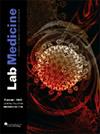ABO/Rh检测,抗体筛选和生物识别技术作为打击保险欺诈的工具:一个例子和讨论
IF 1
4区 医学
Q4 MEDICAL LABORATORY TECHNOLOGY
引用次数: 4
摘要
2012年,超过4700万美国人没有医疗保险;这是一个严重的问题,因为每个人在一生中的某些时候都需要获得医疗保健。据报道,在美国《患者保护和平价医疗法案》(PPACA)通过之前,缺乏健康保险的主要原因是可负担性2010年3月,《患者保护和平价医疗法案》签署成为法律。PPACA的颁布是为了通过提供负担得起的、高质量的健康保险和控制医疗支出来减少没有保险的美国人的数量通过扩大公共(医疗补助)和私人保险,以及通过向符合条件的申请人提供补贴、制定规定、提供税收抵免和保险交换,使健康保险更容易负担得起,来减少没有保险的人数医疗补助扩大条款对各州来说是可选的,因此,一些州选择不扩大资格。PPACA法有一个关于健康保险市场的规定,允许没有保险的个人,以及那些购买了自己保险的人,在补贴的帮助下,比较并以可承受的保费购买健康保险该法案要求保险公司接受所有申请人,无论其先前是否有疾病或性别,并取消医疗福利的年度或终身上限。此外,会员的保险不得因疾病而终止。所有这些规定都允许增加和保留有健康保险的个人生活在扩大医疗补助资格和收入低于贫困水平的州的个人更有可能通过医疗补助获得医疗保险。3即使医疗保险相对负担得起,一些人仍然会出于各种原因不购买医疗保险。那些没有…本文章由计算机程序翻译,如有差异,请以英文原文为准。
ABO/Rh Testing, Antibody Screening, and Biometric Technology as Tools to Combat Insurance Fraud: An Example and Discussion
In 2012, more than 47 million Americans lacked health insurance1; this is a serious problem because everyone will need access to healthcare at certain times in their lives. The main reason for lack of health insurance before the passing of the Patient Protection and Affordable Care Act (PPACA) in the United States has been reported to be affordability.1 In March 2010, the Patient Protection and Affordable Care Act was signed into law. The PPACA was especially enacted to reduce the number of uninsured Americans by providing affordable, quality health insurance and to curb healthcare spending.2 Reducing the number of uninsured is to be accomplished by expanding public (Medicaid) and private insurance as well as making health insurance more affordable by providing subsidies to eligible applicants, instituting mandates, providing tax credits and insurance exchanges.2 The Medicaid expansion clause is optional for states and as a result, some states choose not to expand eligibility. The PPACA law has a provision for a health insurance market place, which has allowed uninsured individuals, along with those who purchased their own insurance to compare and buy health insurance at affordable premiums with the help of subsidies.3 The law calls for insurance companies to accept all applicants regardless of any pre-existing conditions or gender and eliminates annual or lifetime caps on healthcare benefits. In addition, Members’ coverage cannot be terminated due to illness. All these provisions allow for addition as well as retention of individuals with health insurance coverage.2 Individuals living in states that have expanded Medicaid eligibility and have incomes below the poverty level are more likely to obtain health insurance coverage through Medicaid.3
Even with the relative affordability of health insurance, some individuals will not still purchase health insurance for various reasons. States that do not …
求助全文
通过发布文献求助,成功后即可免费获取论文全文。
去求助
来源期刊

Labmedicine
医学-医学实验技术
CiteScore
2.50
自引率
0.00%
发文量
155
审稿时长
>12 weeks
期刊介绍:
Lab Medicine is a peer-reviewed biomedical journal published quarterly by the ASCP and Oxford University Press. The journal invites submission of manuscripts on topics related to clinical chemistry and microbiology, hematology, immunology, transfusion medicine, molecular diagnostics, cytology, histology, and laboratory administration and management. Original research, reviews, and case reports are considered for publication. Lab Medicine is indexed (under the title Laboratory Medicine) by the National Library of Medicine and is included in the PubMed database.
 求助内容:
求助内容: 应助结果提醒方式:
应助结果提醒方式:


